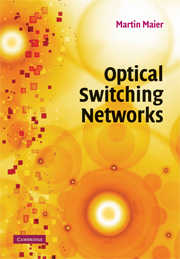Book contents
- Frontmatter
- Contents
- List of illustrations
- List of tables
- Preface
- Acknowledgments
- Part I Introduction
- 1 Historical overview of optical networks
- 2 Optical switching networks
- 3 Building blocks
- 4 Summary
- Part II Optical wide area networks
- Part III Optical metropolitan area networks
- Part IV Optical access and local area networks
- Part V Testbeds
- Bibliography
- Index
1 - Historical overview of optical networks
from Part I - Introduction
Published online by Cambridge University Press: 10 May 2010
- Frontmatter
- Contents
- List of illustrations
- List of tables
- Preface
- Acknowledgments
- Part I Introduction
- 1 Historical overview of optical networks
- 2 Optical switching networks
- 3 Building blocks
- 4 Summary
- Part II Optical wide area networks
- Part III Optical metropolitan area networks
- Part IV Optical access and local area networks
- Part V Testbeds
- Bibliography
- Index
Summary
Optical fiber provides an unprecedented bandwidth potential that is far in excess of any other known transmission medium. A single strand of fiber offers a total bandwidth of 25 000 GHz. To put this potential into perspective, it is worthwhile to note that the total bandwidth of radio on Earth is not more than 25 GHz (Green, 1996). Apart from its enormous bandwidth, optical fiber provides additional advantages such as low attenuation loss (Payne and Stern, 1986). Optical networks aim at exploiting the unique properties of fiber in an efficient and cost-effective manner.
Optical point-to-point links
The huge bandwidth potential of optical fiber has been long recognized. Optical fiber has been widely deployed to build high-speed optical networks using fiber links to interconnect geographically distributed network nodes. Optical networks have come a long way. In the early 1980s, optical fiber was primarily used to build and study point-to-point transmission systems (Hill, 1990).As shown in Fig. 1.1(a), an optical point-to-point link provides an optical single-hop connection between two nodes without any (electrical) intermediate node in between. Optical point-to-point links may be viewed as the beginning of optical networks. Optical point-to-point links may be used to interconnect two different sites for data transmission and reception. At the transmitting side, the electrical data is converted into an optical signal (EO conversion) and subsequently sent on the optical fiber. At the receiving side, the arriving optical signal is converted back into the electrical domain (OE conversion) for electronic processing and storage.
- Type
- Chapter
- Information
- Optical Switching Networks , pp. 3 - 18Publisher: Cambridge University PressPrint publication year: 2008



